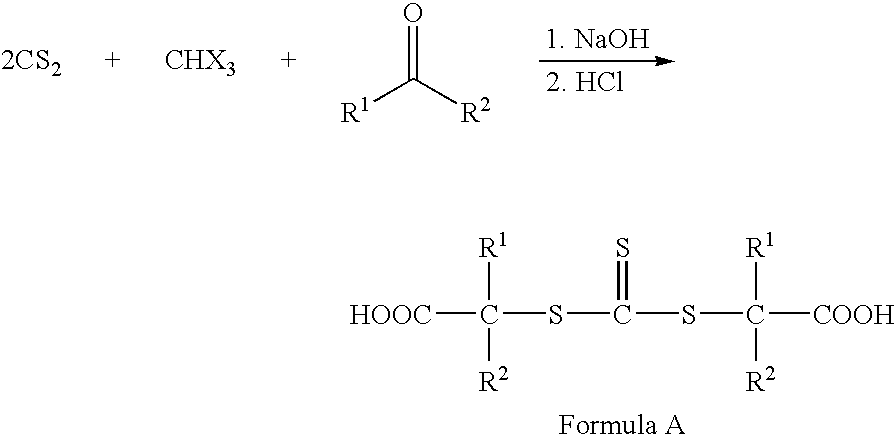Hydroxyl-terminated thiocarbonate containing compounds, polymers, and copolymers, and polyurethanes and urethane acrylics made therefrom
a technology of hydroxyl-terminated thiocarbonate and polymer, which is applied in the direction of synthetic resin layered products, rotary piston liquid engines, machines/engines, etc., can solve the problem that the telechelic di-functional hydroxyl-terminated vinyl polymer is generally not readily availabl
- Summary
- Abstract
- Description
- Claims
- Application Information
AI Technical Summary
Benefits of technology
Problems solved by technology
Method used
Image
Examples
example 1
Synthesis of the Monohydroxyl Terminated Dithiocarbamate Compound
[0104]
Procedure:
[0105]In a 1000 ml jacketed reaction vessel equipped with a mechanical stirrer, a thermometer, a reflux condenser, distillation adaptor, and an addition funnel, 500 grams of ethylene glycol was added and heated to 90° C. under nitrogen. A mixture of 200 grams of the dithiocarbonate and 18.37 grams of the p-toluenesulfonic acid monohydrate was added through the addition funnel dropwise to maintain reaction temperature. A mixture of dithiocarbonate and p-toluenesulfonic acid was added, heated to 110° C. and 60 mm Hg of partial vacuum was pulled to collect water. When no more water was collected and the head temperature dropped and levels dropped off, the vacuum was slowly increased to full vacuum to distill off excess ethylene glycol. When reaction temperature exceeded 90° C., the reaction was stopped. For purification, 250 ml toluene was added when the reaction had cooled and stirred to room temperature....
example 2
Synthesis of Dihydroxyl Dithiocarbamate Compound
[0106]
Procedure:
[0107]In a 500 ml jacketed reaction vessel equipped with a mechanical stirrer, a thermometer, a reflex condenser, distillation adaptor, and an addition funnel, 150 grams of ethylene glycol and 5.57 grams of the p-toluenesulfonic acid monohydrate was added and heated to 110° C. under nitrogen. A mixture of 60 grams of the dithiocarbonate was added through the addition funnel dropwise to maintain reaction temperature. Once added, the partial vacuum was increased to 60 mmHg to remove water. When little water was coming off and head temperature dropped and levels dropped off, the temperature was increased to 120° C. to remove more water. When no more water was removed and head temperature dropped and stabilized, the vacuum was increased to full vacuum to remove excess ethylene glycol. When temperature exceeded 110° C., the heat was turned off. When reaction was room temperature, added 65 ml methyl isobutyl ketone and stirre...
example 3
Synthesis of Monohydroxyl Dithiocarbamate Polymer Containing Repeat Units Derived from Ethyl Acrylate
[0108]
Procedure:
[0109]In a 1000 ml reaction vessel equipped with mechanical stirrer, thermometer, reflux condenser and nitrogen purge, 44.2 grams of the monohydroxyl terminated dithiocarbonate, 395.9 grams of ethyl acrylate, 400 ml of MEK, and 0.5071 grams of Azo catalyst were added. After a nitrogen blanket was applied, the reactants were heated to 65° C. After no further exotherm was observed, the reactants were heated to 80° C. for a period of about 5 hours. The solvent was removed by rotavaporation under full vacuum and 80° C. and a viscous product collected. The structure was confirmed by size exclusion chromatography, hydroxyl number and matrix-assisted laser desorbtion ionization.
PUM
| Property | Measurement | Unit |
|---|---|---|
| temperature | aaaaa | aaaaa |
| temperature | aaaaa | aaaaa |
| temperature | aaaaa | aaaaa |
Abstract
Description
Claims
Application Information
 Login to View More
Login to View More - R&D
- Intellectual Property
- Life Sciences
- Materials
- Tech Scout
- Unparalleled Data Quality
- Higher Quality Content
- 60% Fewer Hallucinations
Browse by: Latest US Patents, China's latest patents, Technical Efficacy Thesaurus, Application Domain, Technology Topic, Popular Technical Reports.
© 2025 PatSnap. All rights reserved.Legal|Privacy policy|Modern Slavery Act Transparency Statement|Sitemap|About US| Contact US: help@patsnap.com



